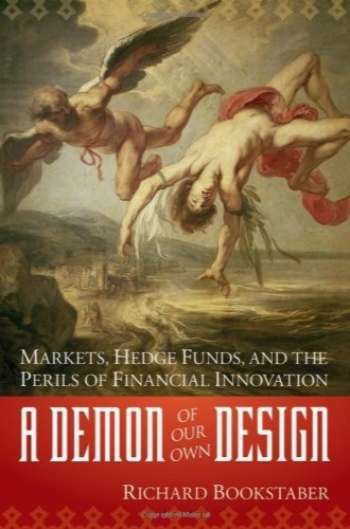دیو خودمان طراحی: بازار صندوق های تامینی و خطرات نوآوری مالی A Demon of Our Own Design: Markets, Hedge Funds, and the Perils of Financial Innovation
- نوع فایل : کتاب
- زبان : انگلیسی
- نویسنده : Richard Bookstaber
- ناشر : Wiley
- چاپ و سال / کشور: 2007
- شابک / ISBN : 0471227277, 9780471227274
Description
The book takes wind from one particularly powerful early paragraph, 'In spite of forty years of progress and a drop in real economic risk by 50% or more, the average annual standard deviation in the S&P500 index was higher during the past 20 years than it was 50 years earlier. Risk should be diminishing, but it isn't.' In addressing this conundrum the book dwells upon the issue of liquidity. Bookstaber outright states that the principal force moving market prices on a day-to-day basis is not new information, it is liquidity. He raises two main points from this: Liquidity problems occur because of continuous reporting. A business with frequent disclosure may be forced by its debtors into bankruptcy, despite having solid assets, as the market falls. Leveraged businesses will in this regard always be at the mercy of the occasional irrationality of market pricing. Furthermore, in a liquidity crisis the correlation between growth assets will move towards one. Bookstaber discusses the example of the Hunt Brothers - major investors in silver and cattle. A collapse in silver prices forced the brothers to sell silver and cattle to meet margin. This led to a collapse in cattle prices (oversupply lowers prices). The take home message - when it comes to risk management during a crisis, usual market relationships are not as important as who owns what, and who needs to sell. But how can a risk manager attain this information? As such, quite unpredictable forces that impact asset prices can force even a good business into bankruptcy. He broadens his scope, emphasising the inherent unpredictability of many market outcomes. The Heisenberg Uncertainty Principle is discussed to show that no event can ever be truly observed, without the observation of that event distorting the event itself. Even if the actions of all market participants were fully disclosed, instantaneously, and for all observers, this disclosure would so modify participant behaviour that the markets would be irrevocably altered. He then discusses the Edward Lorenz Butterfly Effect. Slight differences in initial inputs to non-linear systems can lead to wildly divergent end outcomes. The classic example is the statement by Lorenz that, `One meteorologist remarked that if the theory were correct, one flap of a seagull's wings could change the course of weather forever.' Bookstaber suggests that the financial markets are of similar complexity to the global weather system. As such, specific predictions of even extreme precision are vulnerable to wildly missing their medium term mark. And so, by this stage, he seems to have dismissed the modern practise of risk management. If markets are to a large part moved by low predictability liquidity events, that cannot be observed without interaction, and are subject to the wildly diverse end outcomes of a complex non-linear system, then how can an individual or company maintain reasonable control of their risk exposure?He suggests that companies must more closely resemble cockroaches. Cockroaches are incredibly simple creatures. Yet they have demonstrated an ability to survive across an extraordinary length of time, in a spectrum of climates. Bookstaber suggests that many financial sector firms over-adapt with extreme specificity to the problems that they can identify, piling on leverage and complexity within the limits of their observed risks, and in so doing permitting inordinate vulnerability to the unexpected. Like many extinct species that were fine-tuned to optimisation within their surroundings, they are vulnerable to the situation changing. The answer is robustness. It is the reason that the cockroach has outlasted a plethora of seemingly stronger creatures. The answer, the author concludes, is less complexity and less leverage. I absolutely agree with his conclusions. They are almost obvious. World financial systems will operate more efficiently in the long term if they are less leveraged and less complex. Now it is up to the regulators to enforce a more appropriate use of derivates, and a reduction in gearing.


